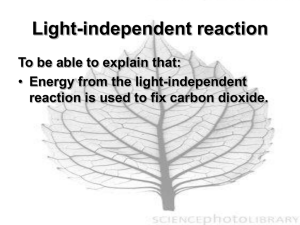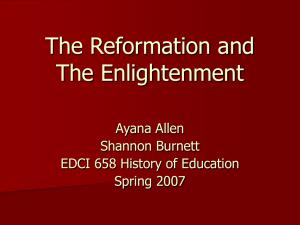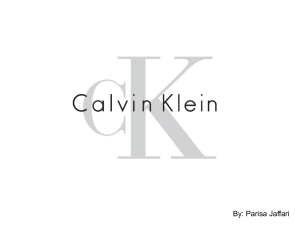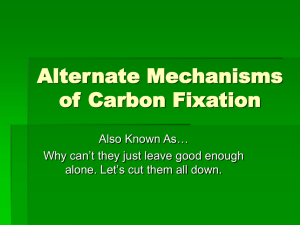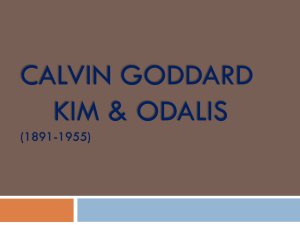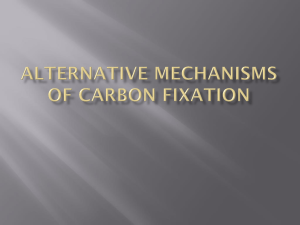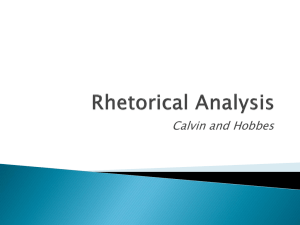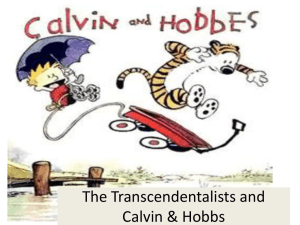A2 4.3.1 Photosynthesis
advertisement
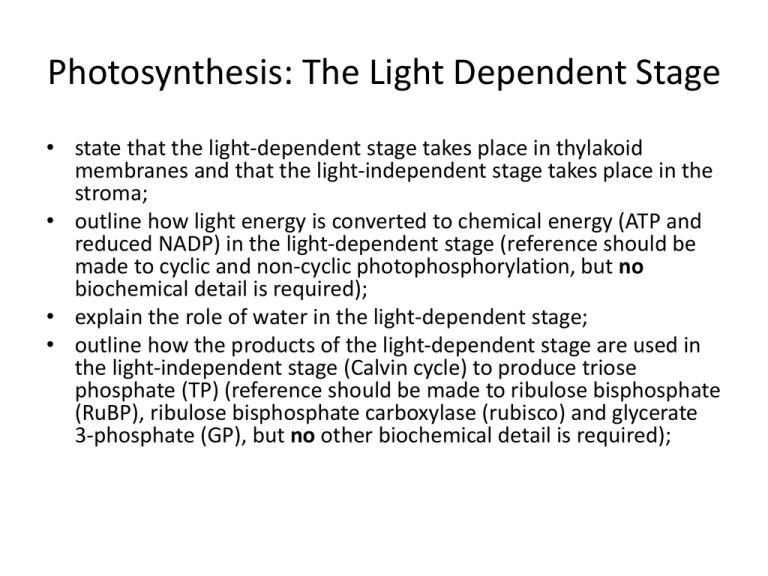
Photosynthesis: The Light Dependent Stage • state that the light-dependent stage takes place in thylakoid membranes and that the light-independent stage takes place in the stroma; • outline how light energy is converted to chemical energy (ATP and reduced NADP) in the light-dependent stage (reference should be made to cyclic and non-cyclic photophosphorylation, but no biochemical detail is required); • explain the role of water in the light-dependent stage; • outline how the products of the light-dependent stage are used in the light-independent stage (Calvin cycle) to produce triose phosphate (TP) (reference should be made to ribulose bisphosphate (RuBP), ribulose bisphosphate carboxylase (rubisco) and glycerate 3-phosphate (GP), but no other biochemical detail is required); Light Dependent Stage • Takes place in the thylakoid membranes of the chloroplast • Photosystems are embedded in these membranes • Photosystem I mainly in the intergranal lamellae • Photosystem II almost exclusively on the granal lamellae • Photosystems trap light energy to be converted to chemical energy Photosynthesis • We will look at what happens with the raw materials in photosynthesis Water + carbon dioxide glucose + oxygen 6H2O + 6CO2 C6H12O6 + 6O2 Stage 1: Splitting Water • Known as photolysis • Enzymes in Photosystem II split water with light into H+ and e• 2H2O 4H+ + 4e- + O2 • Some oxygen used for respiration • Some diffuses out into the air • In this way, water is one of the raw materials in photosynthesis Stage 2: Electron Transport • Just like the one in Respiration, Photosynthesis begins with an electron transport chain called photophosphorylation (as opposed to oxidative phosphorylation in respiration) • It involves Photosystems I and II • A photon of light hits a chlorophyll molecule which excites 2 electrons that have come from water • The electrons are captured by electron acceptors and passed along electron carriers embedded in the thylakoid membranes • Again, the electron carriers are proteins containing iron (like in respiration) Stage 2: Electron Transport • Energy is released as the electrons are passed from carrier to carrier • This pumps protons across the thylakoid membranes into the thylakoid space where they accumulate • A proton gradient forms • Chemiosmosis takes place and the H+ move through ATP synthase and ATP is generated • The Hydrogen acceptor is a co-enzyme called NADP which becomes reduced NADP • This is called Non- Cyclic Photophosphorylation Task • Underneath your copy of the diagram, use the textbooks to describe the sequence of events happening in non-cyclic photophosphorylation Non- Cyclic Photophosphorylation (Z- Scheme) • Photons of light hit photosystem II and move electrons to a higher energy level • ATP is made as the electrons are passed from carrier to carrier • The electrons are passed along a chain of electron carriers to photosystem I • Light energy also hits photosystem I which again, excites electrons which combine with Hydrogen ions and pass to a different electron acceptor (NADP) to become NADPH Cyclic Photophosphorylation • This is another way that ATP is formed, it involves: • Only Photosystem I • Excited electrons from water pass to an electron acceptor, then back to the chlorophyll molecule from which they were lost • Small amounts of ATP are made • It is known as cyclic photophosphorylation Photosynthesis: The Light Independent Stage (Calvin Cycle) • outline how the products of the light-dependent stage are used in the light-independent stage (Calvin cycle) to produce triose phosphate (TP) (reference should be made to ribulose bisphosphate (RuBP), ribulose bisphosphate carboxylase (rubisco) and glycerate 3phosphate (GP), but no other biochemical detail is required); • explain the role of carbon dioxide in the lightindependent stage (Calvin cycle); • state that TP can be used to make carbohydrates, lipids and amino acids; • state that most TP is recycled to RuBP; Calvin Cycle • Takes place in the stroma of the chloroplast • Products of light dependent stage (photophosphorylation) are used Calvin Cycle • Carbon dioxide diffuses into leaf through stomata on underside of leaf and enters stomata • Combines with 5-carbon rubulose bisphosphate (RuBP) helped by the enzyme rubisco • Two 3-carbon glycerate 3-phosphates (GP) created • GP is reduced and phosphorylated by NADP and ATP to make triose phosphate (TP) • Triose phosphate goes on to make sugars e.g. glucose • RuBP is reformed How are the Products of the Calvin Cycle Used? • GP used for amino acids and fatty acids • TP used to make sugars e.g. glucose, sucrose, fructose • TP can be converted to glycerol and combined with fatty acids formed from GP to make lipids • So... • TP can be used to make carbohydrates, lipids and amino acids; • But... most TP is recycled to RuBP Questions 1. Where do the light dependent and light independent reactions take place? 2. Outline how light energy is converted to chemical energy (cyclic and non cyclic) 3. Explain the role of water in the light-dependent stage 4. Explain the role of carbon dioxide in the light independent stage (calvin cycle) 5. What happens to most of the triose phosphate produced in the Calvin Cycle? 6. What else can triose phosphate make? Questions 1. Where do the light dependent and light independent reactions take place? 2. Outline how light energy is converted to chemical energy (cyclic and non cyclic) 3. Explain the role of water in the light-dependent stage 4. Explain the role of carbon dioxide in the light independent stage (calvin cycle) 5. What happens to most of the triose phosphate produced in the Calvin Cycle? Most is recycled to RuBP 6. What else can triose phosphate make? Carbohydrates, lipids and amino acids
